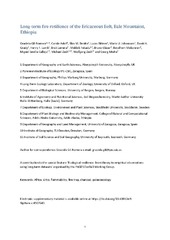| dc.contributor.author | Gil-Romera, Graciela | |
| dc.contributor.author | Adolf, Carole | |
| dc.contributor.author | Benito De Pando, Blas Manuel | |
| dc.contributor.author | Bittner, Lucas | |
| dc.contributor.author | Johansson, Maria U. | |
| dc.contributor.author | Grady, David. A | |
| dc.contributor.author | Lamb, Henry F. | |
| dc.contributor.author | Lemma, Bruk | |
| dc.contributor.author | Fekadu, Mekbib | |
| dc.contributor.author | Glaser, Bruno | |
| dc.contributor.author | Mekonnen, Betelhem | |
| dc.contributor.author | Sevilla-Callejo, Miguel | |
| dc.contributor.author | Zech, Michael | |
| dc.contributor.author | Zech, Wolfgang | |
| dc.contributor.author | Miehe, Georg | |
| dc.date.accessioned | 2020-05-28T11:44:49Z | |
| dc.date.available | 2020-05-28T11:44:49Z | |
| dc.date.issued | 2019 | |
| dc.Published | Gil-Romera G, Adolf, Benito De Pando BM, Bittner, Johansson, Grady, Lamb, Lemma, Fekadu, Glaser B, Mekonnen, Sevilla-Callejo, Zech, Zech, Miehe G. Long-term fire resilience of the Ericaceous Belt, Bale Mountains, Ethiopia. Biology Letters. 2019;15:20190357 | eng |
| dc.identifier.issn | 1744-9561 | en_US |
| dc.identifier.issn | 1744-957X | en_US |
| dc.identifier.uri | http://hdl.handle.net/1956/22397 | |
| dc.description.abstract | Fire is the most frequent disturbance in the Ericaceous Belt (ca 3000–4300 m.a.s.l.), one of the most important plant communities of tropical African mountains. Through resprouting after fire, Erica establishes a positive fire feedback under certain burning regimes. However, present-day human activity in the Bale Mountains of Ethiopia includes fire and grazing systems that may have a negative impact on the resilience of the ericaceous ecosystem. Current knowledge of Erica–fire relationships is based on studies of modern vegetation, lacking a longer time perspective that can shed light on baseline conditions for the fire feedback. We hypothesize that fire has influenced Erica communities in the Bale Mountains at millennial time-scales. To test this, we (1) identify the fire history of the Bale Mountains through a pollen and charcoal record from Garba Guracha, a lake at 3950 m.a.s.l., and (2) describe the long-term bidirectional feedback between wildfire and Erica, which may control the ecosystem's resilience. Our results support fire occurrence in the area since ca 14 000 years ago, with particularly intense burning during the early Holocene, 10.8–6.0 cal ka BP. We show that a positive feedback between Erica abundance and fire occurrence was in operation throughout the Lateglacial and Holocene, and interpret the Ericaceous Belt of the Ethiopian mountains as a long-term fire resilient ecosystem. We propose that controlled burning should be an integral part of landscape management in the Bale Mountains National Park. | en_US |
| dc.language.iso | eng | eng |
| dc.publisher | The Royal Society Publishing | en_US |
| dc.title | Long-term fire resilience of the Ericaceous Belt, Bale Mountains, Ethiopia | en_US |
| dc.type | Peer reviewed | |
| dc.type | Journal article | |
| dc.date.updated | 2020-01-23T10:39:04Z | |
| dc.description.version | acceptedVersion | en_US |
| dc.rights.holder | Copyright 2019 The Author(s). All rights reserved | en_US |
| dc.identifier.doi | https://doi.org/10.1098/rsbl.2019.0357 | |
| dc.identifier.cristin | 1729847 | |
| dc.source.journal | Biology Letters | |
